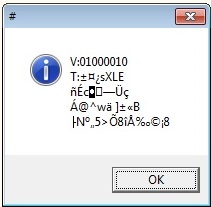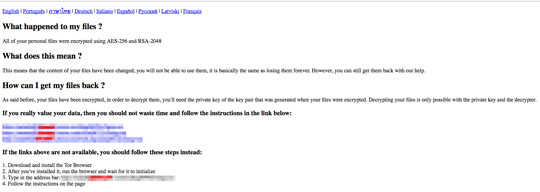RANSOM_NATAS.SM1
Trojan.Gen (NORTON), Troj/Ransom-ECZ (SOPHOS_LITE), Trojan:Win32/Lepoh!rfn (MICROSOFT)
Windows


Threat Type: Ransomware
Destructiveness: No
Encrypted:
In the wild: Yes
OVERVIEW
This Ransomware arrives on a system as a file dropped by other malware or as a file downloaded unknowingly by users when visiting malicious sites.
It connects to certain websites to send and receive information. However, as of this writing, the said sites are inaccessible.
It drops files as ransom note.
TECHNICAL DETAILS
Arrival Details
This Ransomware arrives on a system as a file dropped by other malware or as a file downloaded unknowingly by users when visiting malicious sites.
Installation
This Ransomware drops the following copies of itself into the affected system:
- %AppData%\{Random Folder Name}\{Random File Name}.exe
Autostart Technique
This Ransomware adds the following registry entries to enable its automatic execution at every system startup:
HKEY_CURRENT_USER\Software\Microsoft\
Windows\CurrentVersion\Run
{Random Value} = %Application Data%\{Random Folder Name}\{Random File Name}
Other Details
This Ransomware connects to the following website to send and receive information:
- http://{BLOCKED}qjbssfh6gu.{BLOCKED}n.pw/g.php
It displays the following message boxes:

It encrypts files with the following extensions:
- .txt
- .doc
- .docx
- .log
- .msg
- .odt
- .pages
- .rtf
- .tex
- .wpd
- .wps
- .csv
- .dat
- .ged
- .key
- .keychain
- .pps
- .ppt
- .pptx
- .sdf
- .tar
- .tax2014
- .tax2015
- .vcf
- .xml
- .aif
- .iff
- .m3u
- .m4a
- .mid
- .mp3
- .mpa
- .wav
- .wma
- .3g2
- .3gp
- .asf
- .avi
- .flv
- .m4v
- .mov
- .mp4
- .mpg
- .rm
- .srt
- .swf
- .vob
- .wmv
- .3dm
- .3ds
- .max
- .obj
- .lay
- .onetoc2
- .dot
- .bmp
- .dds
- .gif
- .jpg
- .png
- .psd
- .tga
- .thm
- .tif
- .tiff
- .yuv
- .backup
- .ott
- .ai
- .eps
- .ps
- .svg
- .docb
- .indd
- .pct
- .sqlite3
- .sqlitedb
- .xlr
- .xls
- .xlsx
- .pfx
- .accdb
- .db
- .dbf
- .mdb
- .pdb
- .sql
- .dwg
- .dxf
- .asp
- .aspx
- .cer
- .cfm
- .csr
- .css
- .htm
- .html
- .js
- .jsp
- .php
- .rss
- .xhtml
- .mml
- .stc
- .7z
- .cbr
- .deb
- .gz
- .pkg
- .rpm
- .sitx
- .tar.gz
- .zip
- .zipx
- .rar
- .bin
- .cue
- .dmg
- .iso
- .mdf
- .toast
- .vcd
- .c
- .class
- .cpp
- .cs
- .dtd
- .fla
- .h
- .java
- .lua
- .m
- .pl
- .py
- .sh
- .sln
- .swift
- .vb
- .vcxproj
- .xcodeproj
- .bak
- .tmp
- .rar
- .crdownload
- .ics
- .msi
- .part
- .torrent
- .dll
- .sln
It does the following:
- It detects the following debugger process names for its anti debugging routine:
- ProcessHacker.exe
- tcpview.exe
- autoruns.exe
- autorunsc.exe
- filemon.exe
- Procmon.exe
- Procexp.exe
- idaq.exe
- idaq64.exe
- ImmunityDebugger.exe
- WireShark.exe
- dumpcap.exe
- HookExplorer.exe
- ImportRec.exe
- PeTools.exe
- LordPE.exe
- SysInspector.exe
- Proc_analyzer.exe
- sysAnalyzer.exe
- sniff_hit.exe
- windbg.exe
- joeboxcontrol.exe
- joeboxserver.exe
- Checks for the following USERNAMES to detect if its being debugged:
- SANDBOX
- VIRUS
- MALWARE
- MALTEST
- TEQUILABOOMBOOM
- Directory Blacklist
- SAMPLE
- Detects the presence of WINE:
- wine_get_unix_file_name
- Checks for the following Debugging DLLs:
- Torec.dll
- Sbiedll.dll
- Dbghelp.dll
- Snxhk.dll
- Api_log.dll
- Dir_watch.dll
- Vmcheck.dll
- Wpespy.dll
- Pstorec.dll
- Checks if the filename of the malware is:
- Sample.exe
- It detects the presence of the following dll to avoid detection:
- avghooka.dll
- avghookx.dll
However, as of this writing, the said sites are inaccessible.
Ransomware Routine
This Ransomware avoids encrypting files found in the following folders:
- C:\Windows
- C:\Program Files
- C:\Program Files (x86)
It renames encrypted files using the following names:
- {random characters}.stn
It drops the following file(s) as ransom note:
- HELP_DECRYPT_FILES.html

SOLUTION
Step 1
Before doing any scans, Windows XP, Windows Vista, and Windows 7 users must disable System Restore to allow full scanning of their computers.
Step 2
Note that not all files, folders, and registry keys and entries are installed on your computer during this malware's/spyware's/grayware's execution. This may be due to incomplete installation or other operating system conditions. If you do not find the same files/folders/registry information, please proceed to the next step.
Step 3
Restart in Safe Mode
Step 4
Delete this registry value
Important: Editing the Windows Registry incorrectly can lead to irreversible system malfunction. Please do this step only if you know how or you can ask assistance from your system administrator. Else, check this Microsoft article first before modifying your computer's registry.
- In HKEY_CURRENT_USER\Software\Microsoft\Windows\CurrentVersion\Run
- {Random Value} = %Application Data%\{Random Folder Name}\{Random File Name}
- {Random Value} = %Application Data%\{Random Folder Name}\{Random File Name}
Step 5
Search and delete this file
- %AppData%\{Random Folder Name}\{Random File Name}.exe
- HELP_DECRYPT_FILES.html
Step 6
Restart in normal mode and scan your computer with your Trend Micro product for files detected as RANSOM_NATAS.SM1. If the detected files have already been cleaned, deleted, or quarantined by your Trend Micro product, no further step is required. You may opt to simply delete the quarantined files. Please check this Knowledge Base page for more information.
Step 7
Restore encrypted files from backup.
Did this description help? Tell us how we did.


